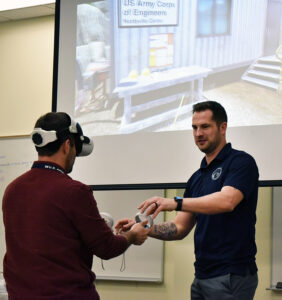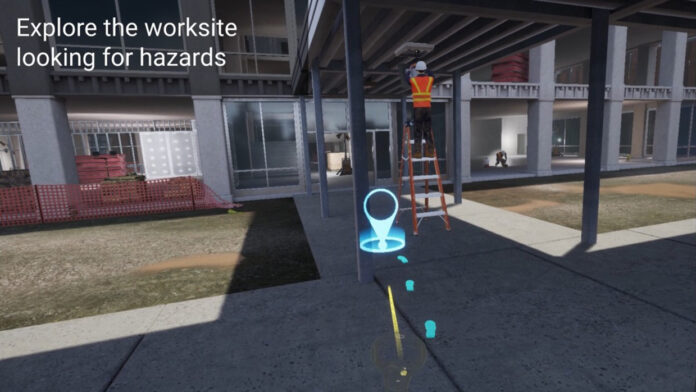HUNTSVILLE – Participants in a construction safety course at the Army Engineering and Support Center in Huntsville toured a construction site, identified safety hazards and experienced the dangerous outcomes of safety violations – all without leaving their classroom.
This real-world experience was made possible by the Army Corps of Engineers Safety Trainer 360, a virtual reality construction site game created by the Huntsville Center Safety Office and the Army Game Studio.
The Safety Office needed a training tool that would allow employees to experience a construction site during the training process. The new tool lets users navigate a computer-simulated construction site while looking for and correcting potential hazards.
The game is the brainchild of Kyle Shireman, Huntsville Center safety manager, who has been working with developers at the Army Game Studio since 2021 to bring his vision to light. Like most innovative ideas, his originated with a problem that needed to be solved.
“We don’t have many construction sites close to our office, and most of the employees attending our safety courses have never been to one,” Shireman said. “But they will eventually be on the job at a construction site, and they need to know what to look for and how to stay safe.
“It’s hard to retain the information in these courses without actually understanding what it looks like.”
 Using computer modeling and simulation, virtual reality provides a realistic, three-dimensional environment that users can explore and interact with. A headset with goggles provides the sight and sound stimuli, and handheld controllers allow the user to move around and make selections.
Using computer modeling and simulation, virtual reality provides a realistic, three-dimensional environment that users can explore and interact with. A headset with goggles provides the sight and sound stimuli, and handheld controllers allow the user to move around and make selections.
“I knew a little about gaming, and I knew that VR is the way of the future,” Shireman said. “Once I found out that the Army Game Studio was doing this kind of work here in Huntsville, I knew we could create something really exciting.”
The Army Game Studio, located at the Combat Capabilities Development Command Aviation and Missile Center’s Software, Simulation, Systems Engineering and Integration Directorate on Redstone Arsenal, is a recognized leader in the development of virtual, interactive and multimedia systems for outreach, education, simulation and training.
The studio, which includes five laboratories, a motion capture studio, a sound studio and an expert team of programmers and designers, is best known for America’s Army, the realistic video game that showcases the Army experience and is often used as a recruitment tool.
Recently, the studio has worked on multiple projects requiring virtual reality, which is growing in popularity because of its inherent training value, said Daniel Kolenich, executive producer of the USACE Safety Trainer 360.
“VR is the latest technology, but not everyone has started using it,” he said. “In this case, it worked perfectly to meet the needs of our customer. We’ve done several virtual reality games, but this one was unique in that it was a real place, so it involved modeling an environment with specific items like cranes and ladders.
“It was far more realistic than what we normally do.”
Most VR games run directly off the headset, but Army Game Studio developers needed more power to create the most realistic environment possible, so the USACE Safety Trainer 360 runs off a high-performance laptop, said Thomas Morris, a systems engineer for Science Applications International Corporation who served as a producer on this project.
The headset — in this case, a Meta Quest 2, formerly known as an Oculus – is tethered to the laptop.
“The computer is what runs the game, not the Quest itself, so it’s much higher in graphics and provides a higher fidelity simulation that was needed for the construction environment,” said Morris. “It’s like the difference between a Fortnite character and more realistic character.”
The high-quality graphics and audio allow users to see and hear vital details, such as a small defect on a tool or the sounds of equipment moving towards them. Paying attention to the small things is often what keeps people safe on a construction site, Shireman said.
“While navigating the VR environment, people are looking for all the potential hazards, and if they miss them, they experience the consequences – for example, a crash for walking under a suspended load, or an explosion from an unidentified electrical hazard,” Shireman said. “We are giving them a chance to learn from their mistakes without actually experiencing any real danger.”
The game is being used for the Occupational Safety and Health Administration 10-Hour Training Course, which is required for all employees in a Quality Assurance role and is recommend for any employee who visits contractor construction or maintenance and service sites. The training provides an overview of QA safety responsibilities and covers general safety topics such as workplace hazards, safety culture and personal protective equipment.
“The game, which is available to download for free for all Department of Defense agencies, can be modified to include additional modules,” said Kellie Williams, safety chief for Huntsville Center. “We are hopeful that after a year of two of use that additional activities and hazards can be added to the game.”
Center employees will have another opportunity to test their safety knowledge and skills on the new virtual reality game during the next OSHA 10-hour Construction Safety training course Feb. 15-16 at Huntsville Center.
Those interested in attending should obtain supervisor approval and sign up by visiting the Safety Office’s SharePoint site and clicking on “Request Training.”
For more information, call 256-609-0558.
Don’t miss out! Subscribe to our email newsletter to have all our smart stories delivered to your inbox.



